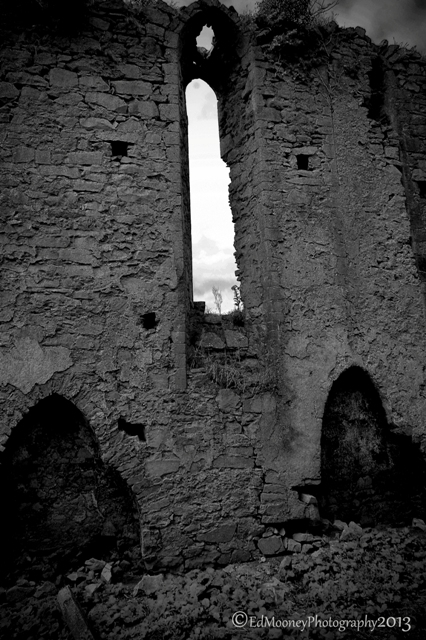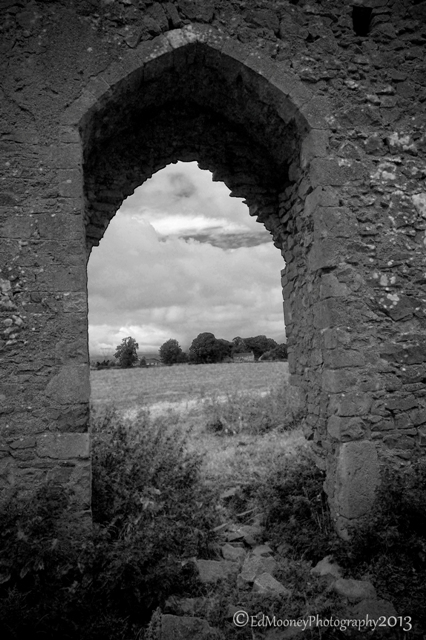I came across the Abbey at Ballyboggan purely by chance after taking a wrong turn. I was actually heading along the Kildare/ Offaly border in search of a couple of De Bermingham Castles which I had missed on by last visit to the area. Out of the corner of my eye, I caught a glimpse of the graveyard through the trees and just had to stop to have a look around. Ballyboggan is situated on the Kinnegad to Edenderry Road in County Meath. Entry to the graveyard is through a roadside gate followed by a lovely tree lined pathway. At the end of the path there is wooden bench and an interesting little stone font with a sign placed on the adjacent tree to denote its use for ‘Holy Water’. From here I was delighted to see the crumbling stone ruins of the Abbey.
Officially known in its Heyday as The Augustinian Priory of De Laude Dei, Ballyboggan Abbey was founded here in the 12th century by an English nobleman, Jordan Comin and dedicated to the Holy trinity. The Priory is probably one of the least known of the Augustinian Abbeys in Ireland today, but is never the less well worth a visit. In 1146AD the Abbey was gutted by a fire and had to be rebuilt. During the medieval period in Ireland, the abbey was home to a beautiful wooden cross which people came from far and wide to see. It was during this time, a very important shrine and point of pilgrimage. After Henry VIII’s suppression of Abbeys in 1538AD the Abbey was dissolved. Along with the abbey, over 5000 acres of land were taken from the local Irish clans and granted to William Bermingham, who later became Lord Carbury. You can read more about Carbury HERE. Later under Elizabeth I these lands were passed on to Edward Fitzgerald and his heirs.
Records from the Annals of Ulster also show that in 1538, following the dissolution of the monastery, the famous wooden cross was burnt along with an image of Mary in the town of Trim. It is also recorded that in 1447, the prior of Ballyboggan was killed by the plague. The walled cemetery is nothing special but it does feature a number of interesting ancient gravestones.
All that remains of the Abbey is a long rectangular looking nave and chancel church, which at some stage was divided in two by a boundary wall. You could easily think that this is in fact two separate buildings as a result of its current condition, but you would be wrong. Though, I would suspect that there were two protruding parts to the church, where the boundary wall now separates the structure. There are doorways in the north and south walls. The east part of the building, where the chancel was, is in better condition and has a large arched window in its gable end. There are also a number of interesting pieces of stonework to be seen. In the middle of the church, in the north wall, is a small projection, which looks like it may have housed a stairway of some description. There are traces of a south transept. At the east end of the north wall are traces of some lancet windows and some tomb niches.
Western section now consists of almost nothing but two long walls. To access this part of the ruin you will need to climb over the boundary wall which separates the church. There is evidence of a large possibly arched window which once stood at the end of this section. At the west end in the north wall there is a pointed doorway part of which has been rebuilt. The west gable is almost totally gone. What does remain are parts of the Nave, the Chancel and the South Transept. Part of the ruin now lies in pasture lands with signs of regular cattle grazing. There are no trespassing signs though so it is quite easy to explore the area. Despite its former importance, the abbey and the surrounding grounds are set a fair distance from the road and have a nice tranquil presence, despite the fact that the site has been clearly abandoned.
For more of my images, why not visit my Website,or follow me on Facebook, Instagram or Twitter.






































Sometimes is good to take a wrong turn……how lovely just to come across it, like hidden treasure, I just love it when that happens. Lovely photos and text 🙂
LikeLike
Thanks Bosslyn, it doesn’t happen to me that often, but when it does its great, 🙂
LikeLike
Wow, this place looks amazing – although maybe best to keep an eye out for falling rocks…
LikeLike
Ha, worse things can happen than falling rocks, all in a days work thought, 🙂
LikeLike
Thanks for taking me on the tour of this place – despite there not being much left of this place, your images are great. Those wrong turnings can lead to some interest ing finds! 🙂
LikeLike
They sure can Sue, Thanks for stopping by, 🙂
LikeLike
beautiful, evocative shots, classically composed.
LikeLike
Thank you, glad that you enjoyed them, 🙂
LikeLike
IN this case, the “wrong turn’ turned out to be the right turn. 😉
LikeLike
Enjoyed both the photography and the research. Well done!
LikeLike
Thanks Guys, delighted you enjoyed them, 🙂
LikeLike
Thanks to my pathetic internet, it took an agonising 7 minutes for this to load in its entirety. However, it was well worth the wait, and each picture kept me entranced and waiting for the next 🙂 You are very talented Ed! Thank you for sharing your photos, experiences and stories!
LikeLike
Thank you for the kind words, they are much appreciated. Slow internet connections are most definitely a curse in the modern world. So glad that you enjoyed this post, thanks for stopping by, 🙂
LikeLike
Ireland is very inspirational if you want to photograph ruins. I noticed some years ago ruins in all sizes and degrees of decay… 😉
LikeLike
gorgeous all around, but I just love that shot of the trail through the trees – completely pulls the viewer in
LikeLike
Thank you, 🙂
LikeLike
I did not realize a water’s source could be holy water. I thought that after the water water had been extracted it was blessed and then it received the moniker “holy water.”
LikeLike
Your right Rob, the font is not a water source, when I saw it first I too taught that it may be a holy well or something, but it just seems to be a font.
LikeLike
I just love the photos where you can see the sky through the doors and windows. Fabulous post and photography!
LikeLike
Thanks Leanne 🙂
LikeLike
A kind of photo documentary 🙂
LikeLike
This is a beautiful picture, thank you so much for sharing!!
LikeLike
My pleasure, so glad that you liked it, 🙂
LikeLike
I love monochromatic photography. You really did a fabulous job with these pictures Edward!
LikeLike
Thank you Yael, Im still learning, but I just like the way the mono works with these shots, 🙂
LikeLike
Pingback: Kinnefad Castle | EdMooneyPhotography
Pingback: Grange Castle | EdMooneyPhotography
Pingback: Donadea Castle | EdMooneyPhotography
Pingback: Dunfierth Church | EdMooneyPhotography
Pingback: Re-work Wednesday 46 | EdMooneyPhotography
That was a wonderful wrong turn to take.
LikeLiked by 1 person
Ha, Ha, Im forever doing that. Although it must be about two months since I was last out on the road. Perhaps Santa will get me some free time for Christmas ??? 🙂
LikeLike
Pingback: Grange Castle | Ed Mooney Photography